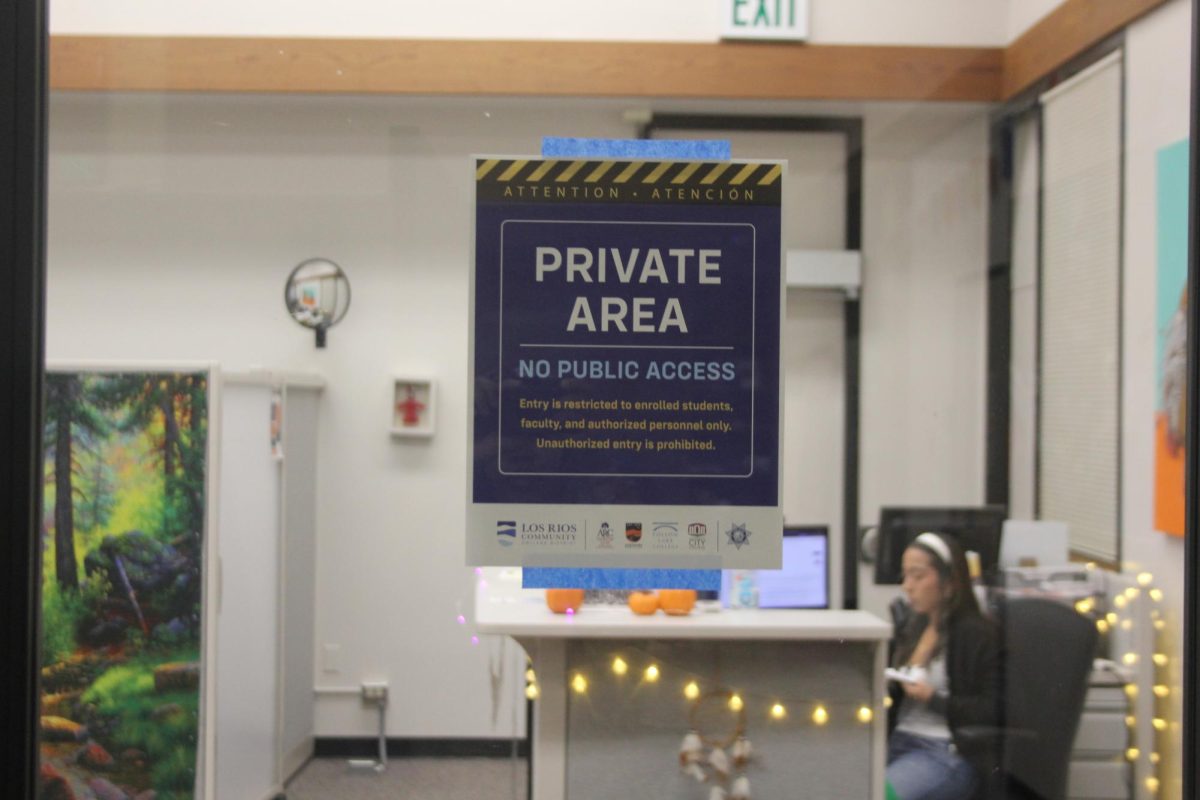Los Rios Community College District officials posted signs this semester on the doors throughout American River College, Folsom Lake City College, Sacramento City College and Cosumnes River College that designate private and public spaces.
Tadael Emiru, the vice president of student services, said a private area on campus refers to areas such as classrooms that are designated for professors and students enrolled in those classes, while a public space, such as the library or cafeteria, is accessible to any individual on campus regardless of enrollment status.
Emiru said that the signs aren’t meant to prevent students from accessing the spaces they need to be in but to ensure the safety of students, faculty and staff.
The distinction of these areas comes as a result of the possibility of the U.S. Immigration and Customs Enforcement stepping onto college campuses, said Emiru.
“This is meant to clearly communicate that our campus, our classroom spaces and other spaces are not meant for anyone from outside to just simply march in,” Emiru said.
College President Edward Bush said it is important that students and staff know that these signs are posted as a reminder that the institution is doing everything that they can and stands in solidarity and support of those with different immigration and documentation statuses.
“Our colleges are safe. The fact that safety is being questioned based on how ICE agents are being deployed, you know coming in, not even showing ID,” Bush said. “Adds to this heightened sense of fear.”
Bush said that the district is trying to explore every kind of legal mechanism that they have, to affirm the individuals in this situation.
“At this scale, underneath this type of overt structural agenda to create the fear that is sanctioned federally is a different kind of issue than we’ve had to face before as it relates to safety, our folks being safe on campus,” Bush said.
Bush said that given the reality of our current presidential administration, there isn’t anywhere that ICE is unable to go.
It is a sobering reality not being able to ensure that individuals are fully protected in the instance that ICE were to come onto CRC campus, Bush said.
“It’s a different threat to safety within our own government that we hadn’t necessarily had to fully account for before. So being able to operate with authority and aspect of law on their [ICE] side, that is threatening,” Bush said.
If ICE were to become present on CRC campus, the first step would be to notify the Los Rios Police Department, Emiru said.
LRPD Capt. Christopher Mora said the department is very well prepared.
“We go by the California Values Act,” Mora said.
The California Values Act ensures that no state and local resources are used to assist federal immigration enforcement and that schools, hospitals and courthouses are safe spaces for everyone in the community, according to The American Civil Liberties Union of Southern California.
The LRPD has many examples of notices, orders and warrants to verify authenticity of authority.
“We have examples of what a true order should look like so that we can compare and verify that it’s a legitimate order and not something some kid made up and came acting like they’re an ICE agent,” Mora said.
If ICE agents choose to ignore the signs declaring private areas, it is heavily discouraged to try and stop them. Students should be reminded of their right to remain silent and the events of the altercation should be documented via note taking or video recording, Mora said.
“I cannot advocate or support someone who will try to disrupt what an armed officer is doing,” Bush said.
Trying to put yourself between armed officers that are seeing their way into a private space creates safety concerns, Bush said.
Emiru said we can’t stop ICE agents from coming to CRC.
“If immigration enforcement has a warrant for you, they have the authority to act on that warrant,” Mora said.
Bush said the college has taken steps within their power to create the safest environment possible for all students.
The signs should serve as a reminder of an affirmation of the college values and a commitment to student equity and success, Bush said.
Mora said he doesn’t believe CRC is on ICE’s radar at this time.
“I think ICE would rather go to some place where they can ‘cast a big net’ and get a lot of people,” he said.
Tai Khounnha, a 20-year-old history major, said he doesn’t see the signs much around campus and he doesn’t know the purpose of them being posted.
Khounnha said that a schoolwide newsletter or announcement could be a better way to get the message of these signs across to members of the campus.
“I feel like they should definitely be doing more because that seems very minimal,” Khounnha said.
Administrative assistant Valerie Mendoza said she initially didn’t know what the signs were for, but she believes it is incredibly important that the campus takes measures to protect students from ICE.
Mendoza said the signs may cause some confusion amongst students about their purpose but proper communication about the signs could reduce the issue.
“I hope they’re not hindering students from recognizing that it’s not at them,” said Mendoza, whose parents are immigrants. “It’s actually towards the other groups who aren’t meant to be on campus and that are harming them.”
The Immigrant Legal Resource Center has made available red cards that contain a script that individuals can use if approached by an immigration officer. Students can pick up a red card in the Health and Wellness Center
Staff writer Sloan Campbell contributed to this story.

